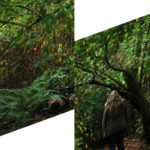It just didn’t make sense. How could a blind person not realize he was blind? But that’s what it was saying, and the Bible doesn’t lie.
Rev 3:17 Because thou sayest, I am rich, and increased with goods, and have need of nothing; and knowest not that thou art… blind…
I realized the verse was speaking about spiritual blindness but I thought I might get some direction by learning more how physical eyesight works. Perhaps physical and spiritual eyesight were counterparts.
The first thing I learned was that we have two types of vision cells to see everything about us, called rods and cones. Rods are for low light conditions and respond to 1/100th the light energy than cones need. To make up for their weak signals to the brain the Creator has bundled them with other rods to strengthen the input through the optic nerve. Rods sharing a common nerve are like fingers sharing a common arm. The downside of this arrangement is that rod vision cannot provide clarity, because the brain cannot pinpoint exactly in the retina where the rod resides. Another difference between rods and cones is that rods cannot detect color. They can only distinguish between light and dark. So if our retina were populated only by rods we could not see clearly nor in color. But if we had only cones to see the world about us we would see everything clearly and in full color, and not just where we are looking but also our side vision! However, in low light conditions, where there wouldn’t be enough light energy to activate the cones, we would be sightless.Not good on this earth!
At this point I noticed an experience recorded in Mark 8, where there was a discussion about bread. The story begins at the 14th verse. (My quotes are from the God’s Word translation.) This was right after Jesus had performed a second miracle of feeding thousands from a few loaves and fish, but this time as they got into their boat the disciples had taken with them only a single loaf of bread and were discussing the oversight.
At this point Jesus said, “Be careful! Watch out for the yeast of the Pharisees and the yeast of Herod!” Of course the disciples thought their teacher was referring to bread, which they were talking about, but Jesus added, “Why are you discussing the fact that you don’t have any bread? Don’t you understand yet? Don’t you catch on? Are your minds closed? Are you blind and deaf? Don’t you remember?”
The men were dumbfounded. They didn’t have a clue what Jesus was talking about. So the master asked them a question. “When I broke the five loaves for the five thousand, how many baskets did you fill with leftover pieces?” They answered, “Twelve.” Then He followed with another question, “When I broke the seven loaves for the four thousand, how many large baskets did you fill with leftover pieces?” And they replied, “Seven.” But they were still clueless.
I was really getting into the story, but to my dismay it appeared Christ ended it with a final question, “Don’t you catch on yet?” Mark then goes into another story, about a blind man being healed.
“Beware of the leaven of the Pharisees…” Jesus must have seen a dangerous trend among His disciples with all the attention they were getting as His students. Perhaps a Laodicean trend? Had not they healed the sick themselves and cast out devils just like their Teacher did? (Mark 6)
The hypocrisy of the Pharisees was the product of wanting great things for themselves. The object of their lives was personal glory. This led them to pervert and misapply the Scriptures, which blinded them to the purpose of Christ’s mission. Even Christ’s disciples were in danger of cherishing this subtle evil. Though they outwardly left all for Jesus’ sake, they had not in heart ceased self-seeking. As leaven, if left to complete its work, will cause corruption and decay, so the self-seeking spirit, if cherished, will defile and ruin the soul. (Adapted from Desire of Ages 409)
To counteract this, Jesus led them back to where they did many miracles and fed the 5,000—Bethsaida, a city defiled by the leaven of the Pharisees, and one to which Christ said, “Woe to you, Bethsaida, for if the mighty works which were done in you had been done in Tyre and Sidon, they would have repented long ago in sackcloth and ashes.“ (Matthew 11:21) When they arrived, someone brought a blind man and asked for Jesus to heal him. Christ now had exactly what He needed to show His disciples (and us) why He called them “blind” earlier in Mark’s chapter, and later in Revelation 3.You might remember the incident. This is the only miracle I know of that Jesus did in two parts. And He did it for a very good reason. In the first part He used spit. There are only three miracles recorded where Jesus used spit, and each of them involved something disgusting to the Saviour. I’m sure this one had something to do with the “leaven of the Pharisees”. After He spat on the eyes and put His healing hands on the man Jesus asked how things looked. The man replied, “Unclear, people look like walking trees.” But, hey, he could see finally. Jesus, of course, wasn’t content with leaving the man in this condition, just as he wasn’t content in letting His disciples see as they did. He had something better! So He touched his eyes again, without the spit, and bade him “Look up!” And the record says, “…he was restored, and saw every man clearly.”
What it appears that Jesus did first, using the spit along with the touch, was to activate his rod cells. This would open the man’s eyes so he could see, but things wouldn’t be clear. That’s where the disciples were spiritually. The second time Christ would turn on the cone cells so he could see clearly. But cones would also bring color along with high definition– a whole new way of seeing.
The disciples were feeling good about their favored condition. Soon Jesus would assume His kingship and all of them would be placed in high positions in the new kingdom… or so they thought. However, Jesus saw a different future for them. Very different. And they weren’t ready for it yet. And until they would feel their desperate need of a Saviour, even if they could perform “many mighty works,” they were destined to be spewed out of God’s mouth, as John would later say in Revelation 3.
So now I understood how I could be blind and think I could see just fine. If my view of the kingdom is still centered around myself, and am still allowing the leaven of self-seeking to moderate my actions, I have been bewitched by “the leaven of Herod and the Pharisees,” and, as far as God is concerned, I am blind and desperately need His eyesalve so I can see as Jesus sees, with a view to bless God and serve others unconditionally.
Thank God for counterparts!
In the next post I will share what I learned about these counterparts going the other way, from the spiritual to the physical.






